15 Organized Classroom Hacks that Will Transform Your School Year
Sometimes, the most creative and passionate teachers struggle to keep an organized classroom. Having a gorgeous, streamlined classroom doesn’t make you a great teacher, but it sure can help keep you sane, and it has lots of other benefits, too!
The truth is that organization and time management don’t come naturally to everyone. Is this a struggle spot for you? If so, you have two choices: 1) learn to live with it or 2) continue to grow as an educator.
Read more below about the benefits of an organized classroom, some organized classroom hacks, and some tips for getting started quickly.
As an Amazon Associate, I may make a small commission if you click on any of the links below. This does not affect your purchase price, and I always use and enjoy purchases before recommending them.
Organized Classroom Hacks
Below are some of my favorite organized classroom hacks.
Color Coding Everything
This coworker of mine teaches first grade out of a portable. One of the biggest challenges of working in portables is the lack of built-in storage.
She added color to her class and provided some organization for her students by spray painting all her materials buckets and go home trays. Her students are each assigned a number so she doesn’t have to re-do this every year.
Here’s everything you need to make this happen:
- Spray Paint
- Large Three Drawer Organizer
- Smaller Three Tray Organizer
- Editable Labels for Sterilite Drawers from TPT
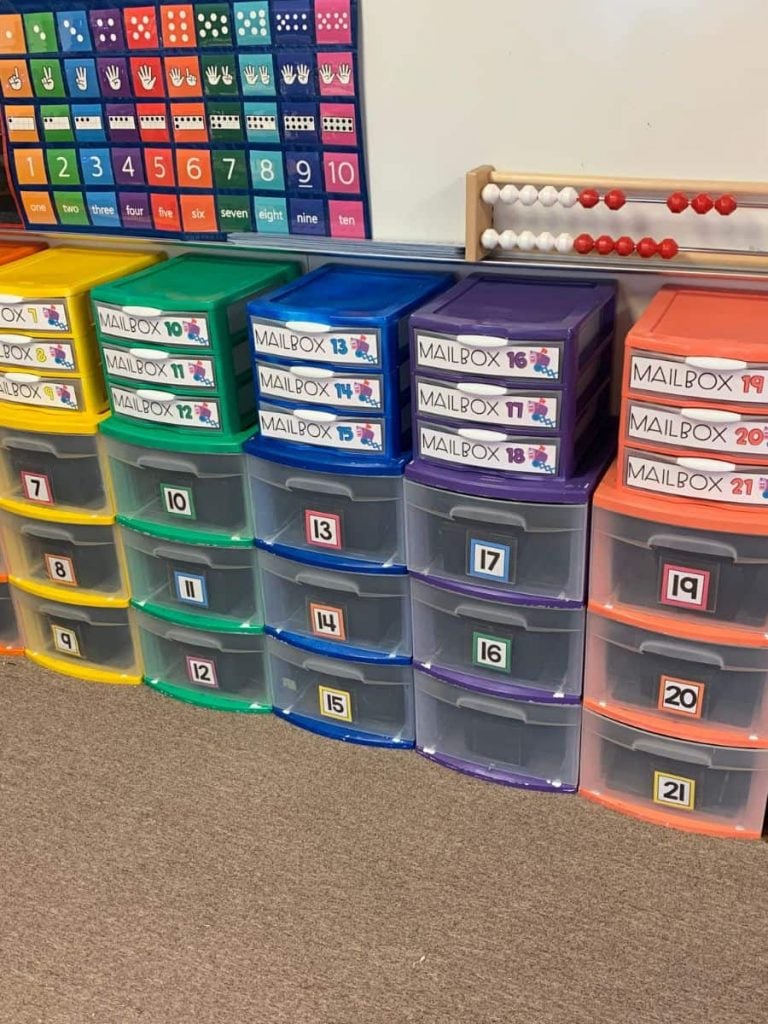
Teacher Toolkits
You can find these toolkits at Home Depot, and then spray paint them (or not). Some teachers enjoy using these if they don’t have a traditional teacher desk in their classrooms. You can also purchase these fun labels on TPT.
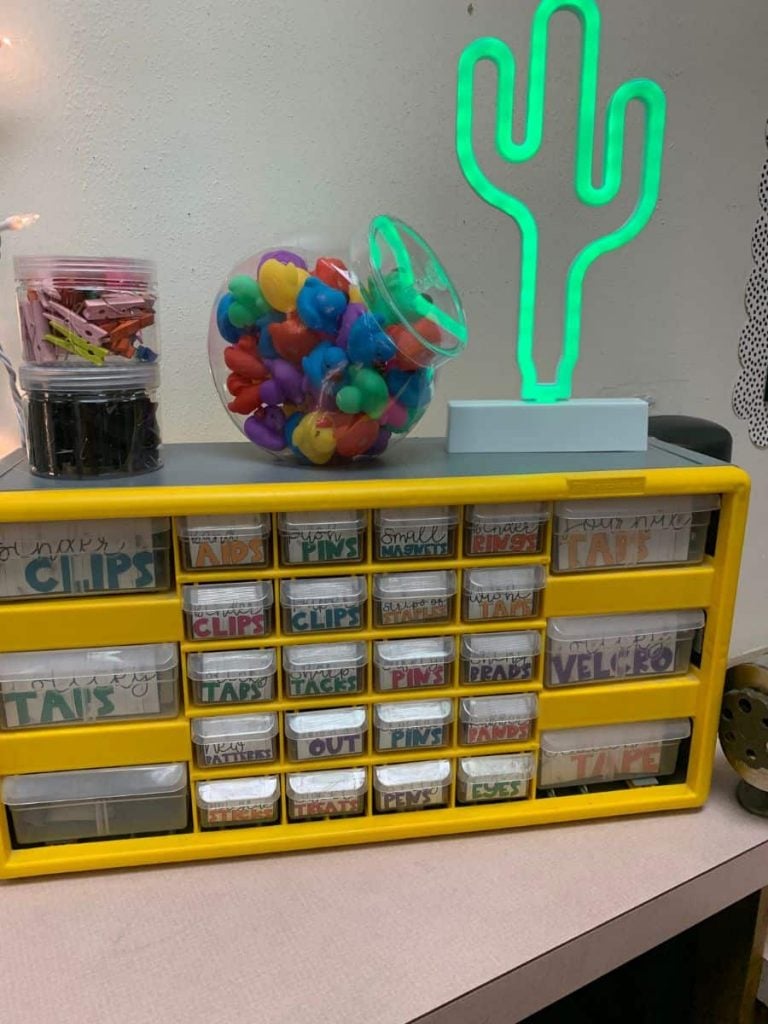
Rag Curtains to Hide Cords
One way to reduce visual clutter is to hide all those awful cords. This teacher makes frequent use of rag curtains all around her room, which is an easy and affordable way to hide all sorts of things!
Here’s an easy video tutorial for making rag curtains.
You’ll need the following supplies in most cases:
- 3M Hooks
- Tension Rod
- Fabric
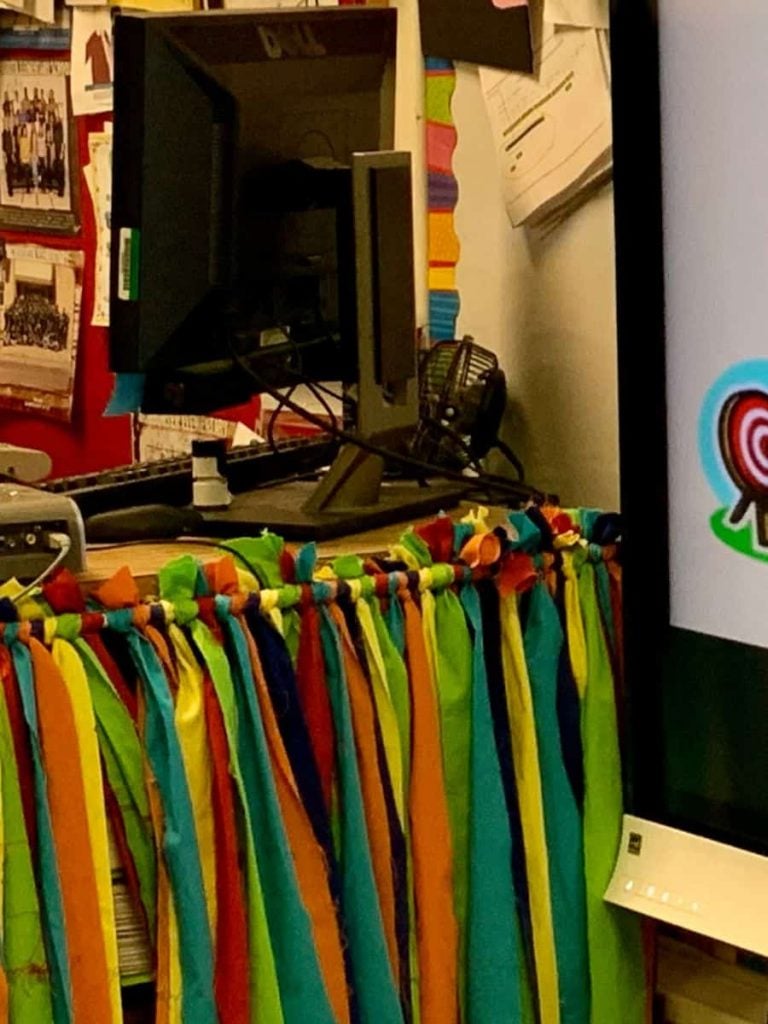
Duck Tape to Code Composition Books
This is such an easy way to visually identify different subjects for students. In this self-contained classroom, math, science, social studies and RLA each have their own composition book. She can tell her students to “go get your orange notebook” and students can quickly access materials.
Find colorful Duck Tape on Amazon.
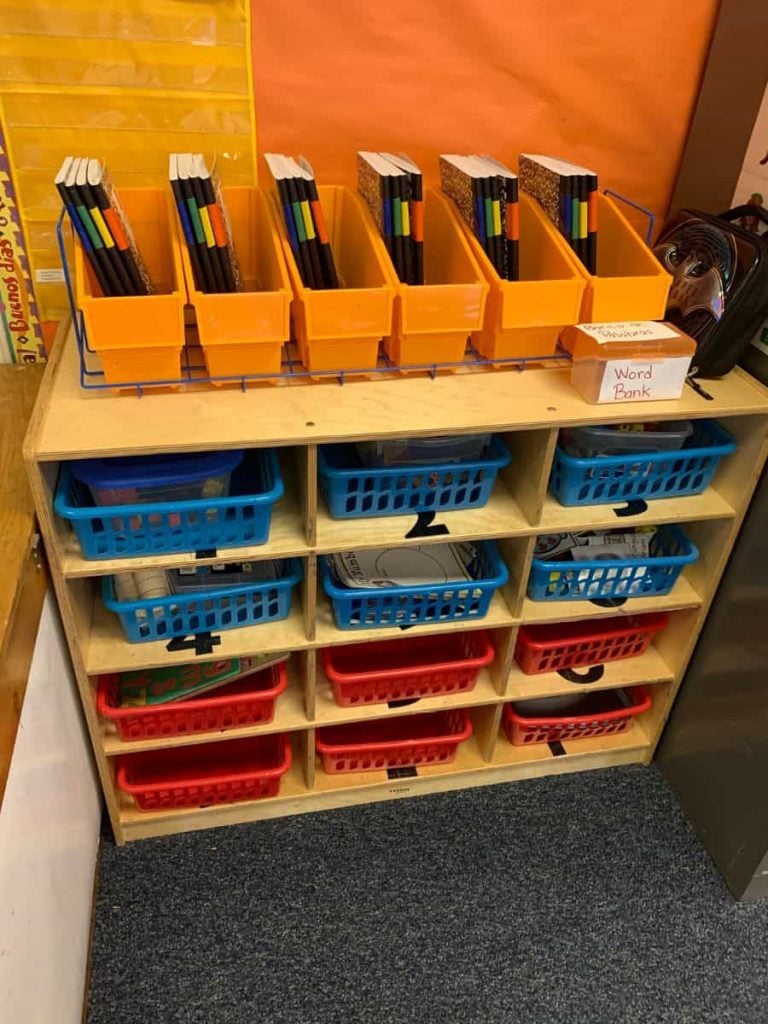
Names on Your Student Work Wall
I’ve always just had unnamed clips on the wall to showcase student work. I like giving each student their own designated space, as this teacher has done. This allows teachers to quickly notice whose classwork hasn’t been changed in a while. Conversely, if you’re proud of how well a particular assignment worked, you can show every student’s attempt.

Strategically Designed Flow of Traffic
This teacher expressed frustration that the constant hand-washing during the 2021-2022 school year had become a distraction for students.
She used her existing furniture to create a mini hallway, and had a rule that only one person could be there at a time.
This furniture obscured students’ view of the sink, and soon, everyone stopped paying attention.

Supply Baskets under Chairs
This teacher wanted to keep her tables rather than desks, but was looking for ways to keep her kids contained rather than roaming the room for supplies. She suspended these baskets under chairs with simple zip ties.

High Frequency Tools in Easy Reach
This teacher’s standing desk is fabulous, but most of us don’t have the money to pay for one. I also appreciate that she’s got her most frequently used resources available in the baskets and hanging cups attached to the desk.
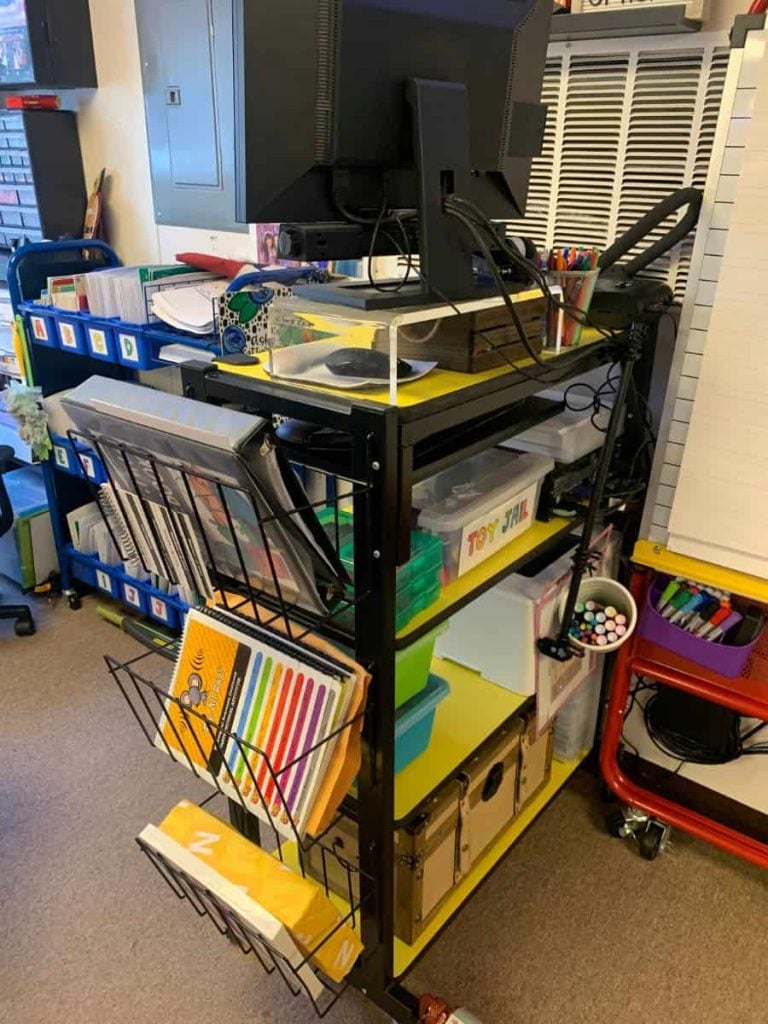
Leveled Reader Organizer by Lakeshore
This leveled library mobile storage cart by Lakeshore is so handy for the lower grades. I love the removable bins, because it would be really handy if you’ve got ability groups or partners that might share a bucket at their table. Because it rolls, you can easily tuck it away when it’s not in use.

Tiny Tension Rods for Anchor Charts
I love the way this teacher hangs anchor charts around the room. To save space, she puts them on binder rings so she can easily flip them as they’re addressed in class. Here’s all you need to make this work:
3M Hooks
Tension Rod
Binder Rings

Hidden Storage Everywhere
This teacher uses the rag curtains described above to hide almost every square inch of storage in her classroom. None of her bookshelves are exposed, which means less visual clutter.
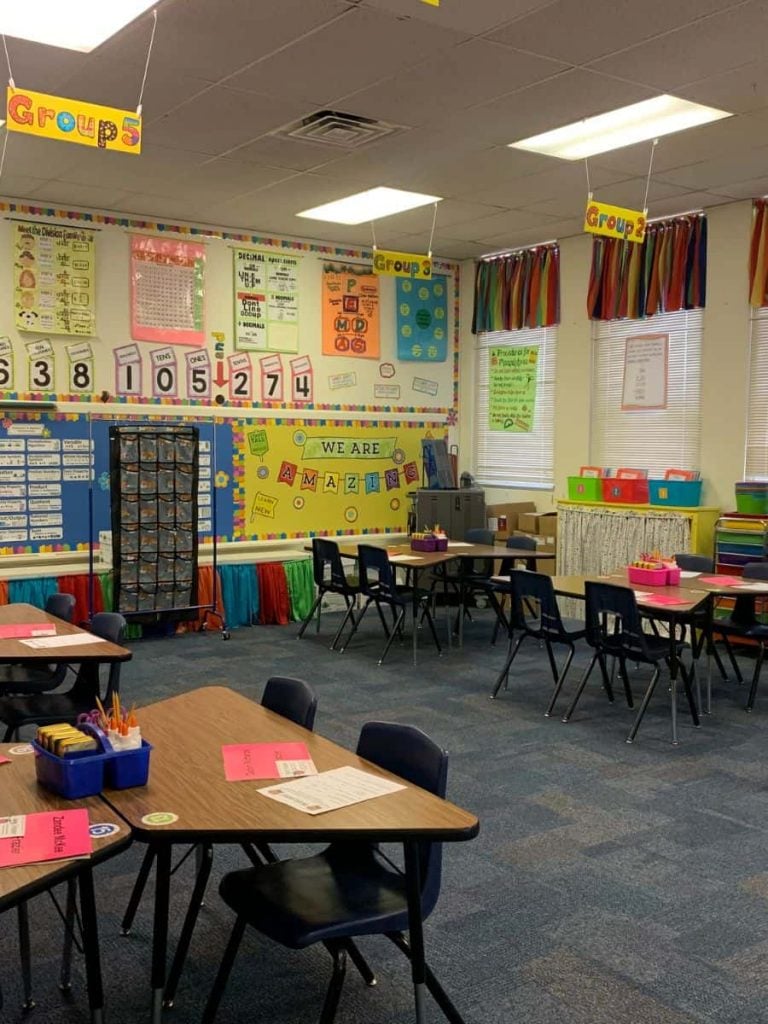
Picture Frames for Objectives
I like how this teacher has found a way to quickly change out her posted objectives without eating in whiteboard or floor space. This bulletin board is right behind her desk. By using inexpensive glass picture frames, she can easily wipe away Expo marker and change out her objectives without fuss.
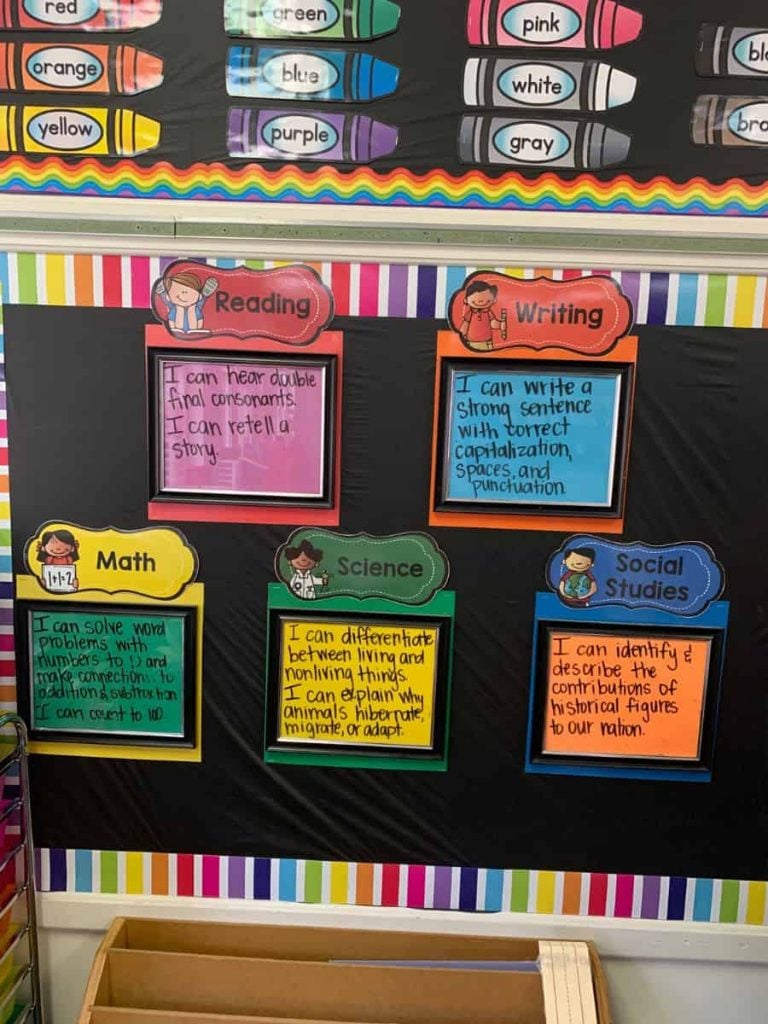
Repurposed Furniture for a Standing Desk with Storage
There were quite a few of these furniture pieces that were not being used in our school. At some point several years ago, it became on-trend to ditch a traditional teacher desk and switch to a much smaller standing desk at the front of the room near the board.
Since most elementary school teachers have a kidney table for small group work, teachers began to use that for their main desk, too. By simply adding storage behind the kidney table, both students and the teacher can work throughout the day. This saves valuable floor space.
The furniture pictured below is not technically a standing desk, but several teachers in our building repurposed this standard-issue furniture item into one. It has built-in-storage, which keeps them organized.
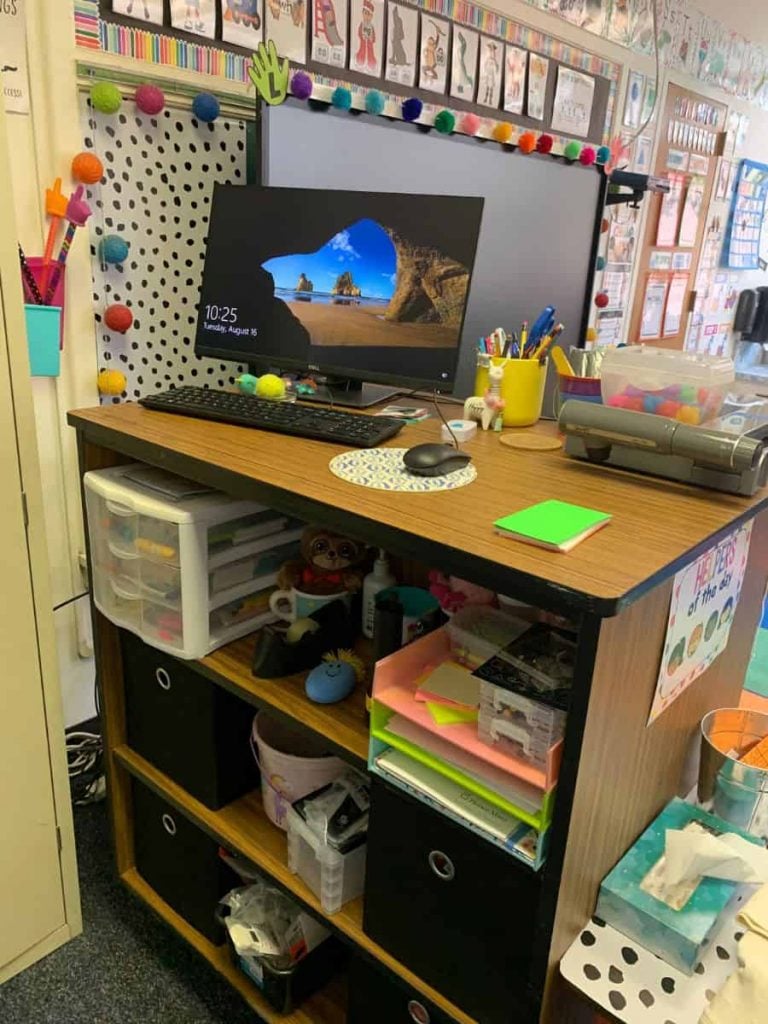
Clear Storage Containers Everywhere
Try to work toward switching all your storage containers to clear, so that you can quickly and easily see what’s inside. That doesn’t mean you have to immediately throw everything out; remember that all changes can be gradual if need be.

Over-the-Door Shoe Organizers
I like these over-the-door shoe organizers for storing things like headphones, which need to be accessed quickly and frequently. Since headphones are kind of gross to share between students, most teachers will label the pockets with student numbers.

The Benefits of an Organized Classroom
Here are some benefits of an organized classroom. There are plenty of reasons why you wouldn’t want to just shrug your shoulders and live in a chaotic space.
Pacing and Classroom Management
Classrooms that are organized well tend to have better classroom management, because kids can always find what they need, and so can you.
When kids can easily and quickly access what they need, there’s less down time, and that means your pacing will be quicker. When you can move at a quick clip you develop a sense of urgency and cover more material quicker.
Impressions on Outsiders
You know you’re a great teacher, even with the mess.
But outsiders are less likely to give you the benefit of the doubt. Unfortunately, it’s a well-known fact that teachers who have messy classrooms can make bad first impressions on parents, administrators, and instructional coaches. Like it or not, people will make assumptions about your professionalism and teaching abilities based on the state of your classroom.
Because administrators aren’t in your classroom that often, they often won’t move past that first impression unless your student data is outstanding.
Less Clutter, Less Chaos
Some people, including students, will find it hard to relax and settle into a classroom that’s got too much clutter. If that doesn’t describe you (or if your own home is cluttered and busy), you may not realize how much it will affect the thinking of students in your class.
This post from NBC News says, “Evidence suggests that when multiple visual stimuli are competing for your attention, you have a harder time narrowing your focus to only one of them. That means the clutter in your life is making you unfocused.”
Managing Traffic Flow, Managing Personalities
You want to minimize opportunities for your students to bump into one another or be crowded into small spaces as they look for supplies.
If you’ve got stuff shoved into random places, and students are having to cluster up in your classroom due to too much furniture, you’ll find that little arguments and pushing and shoving happen more often between the bigger personalities in your room.
Fewer Outside of Contract Work Hours
Teachers who struggle with organization often find themselves busily working for hours outside of school re-tidying their messes rather than spending time with friends and family. This is a sure recipe for burnout!
If you can get organized and pare down your messes, you’ll have less work to do outside your contracted hours.
How to Get an Organized Classroom FAST
Becoming an organized teacher certainly doesn’t happen overnight; especially if you’re hardwired to live with a bit more chaos. So look for opportunities to make quick and easy changes.
Remove unnecessary furniture first.
One of the women on my teaching team had way too much furniture in her room. Consequently, she filled it all up, and rarely used any of it.
Look for your least functional bookcase or storage unit, and decide to be done with it. If possible, remove another large furniture item, too.
By getting rid of the furniture that holds all the supplies, you’ll be required to pare down your books and materials, too.
Getting rid of the furniture FIRST holds you accountable to doing the harder work.
Start your transition to digital file keeping.
- Go through your filing cabinets and remove anything you haven’t used in the last year.
- Start a Google Drive, and begin to make folders to house all your documents.
- Throughout the year, as you use hard copies kept in your file cabinet, scan in a PDF to use next time. Toss the file once you’ve created a soft copy.
- At the end of the year, anything remaining in the file cabinet can go; after all, either you never used it this year or you made the soft copy already.
Get rid of everything you won’t use this year.
So many teachers will hold onto things year after year because they might change grade levels or subject areas. While you may occasionally find use for these items, most of it is junk you’ll never touch again.
Only you know what’s reasonable to keep and what’s holding you back.
Host a freebie sale.
This is one of the fastest ways to get rid of stuff. Pile it all into one section of your room, and send out an all-staff email about the freebies you’ve got available. Give everyone a deadline, and then decide to either sell the rest, donate it, or bust out the janitor’s big black garbage bag.
Sell on Facebook.
You probably have tons of local buy-sell-trade groups on Facebook. Homeschooling moms in particular love to purchase from teachers.
Get a janitor’s big black garbage bag.
Some of the stuff on your shelves may be so outdated or in such poor condition that it will make more sense to simply toss it.
Hide your storage behind curtains.
Hide those bookshelves behind curtains. You don’t have to sew, even if you don’t want to make rag curtains! With a stapler, some fabric, and some tension rods, you can make the magic happen.
Switch to clear containers, if possible.
Ideally, you want your math manipulatives, googly eyes, crayons and everything else in clear containers so you can easily see inside them. That works much better than labeling things!
Get serious about time management.
Honestly, most of what’s described above is just a band-aid that will make you feel better. To have a truly organized classroom, you’ll need to have excellent time management. While some people come by this naturally, others have to really work hard at becoming more disciplined with their time. Here are my best ideas.
Set a weekly goal for hours at work.
This is a big concept for the women in the 40 hour teacher workweek. Instead of just staying until the work is done, or giving up completely, set a reasonable goal for yourself for how many hours you’re willing to work outside of your contract. Once you’ve hit your limit for the week, go home. You’ll get better at using your time wisely over time.
Set priorities.
If you could only do a really wonderful job at three things this week, what would those be? Would you internalize your lesson plans better to improve your pacing? Would you have all your copies for next week made before you leave on Friday? What “game-changers” could you focus on this week, and let the rest of it just go? Do you really NEED to take all those grades?
Know your time-of-day capacities and plan accordingly.
I quickly learned that by 4:00 pm each day, I’m already on the brink of mentally tapped out, and I’ve still got to get three kids picked up from daycare, fed, bathed and put to bed. After school is NOT the time for me to be checking things off my to-do-list.
Instead, I got a lot smarter about my conference period, and started arriving to school at 7:00. When absolutely necessary, I do work on the computer after my kids go to bed and when I’m in my pajamas. I’m a morning person, so while I don’t LOVE getting to school early, it’s when my brain is sharpest. It’s saved me a lot of wasted time.
Teach your students to clean – and to do it better than you would.
I put strict processes in place for our end of the day clean-up. My students would tidy, carefully adjust desk legs to put them back in place, straighten out rugs, erase boards, sanitize surfaces, sharpen pencils, pass out paperwork, write the next day’s lunch choices, and more.
While they worked hard, I would post the next day’s objectives, and set up materials. We did this in the last 7 minutes of every school day, and I left behind a sparkling classroom every day.
I used games like Magic Trash to keep them working hard on their jobs, and found other silly ways to reward kids for excellent janitorial work. We also talked about honoring our janitorial staff and the hard work they do.
Use time wisely on campus.
It can be tempting to waste your conference time away chatting with your bestie and catching up on your personal lives. After all, adult conversation can feel pretty rare and refreshing. However, there are a certain number of things that are just too hard to get done at home.
I liked to use my conference time for making copies, since they were always busy before and after school (and I can’t do it from home). Also, during my conference, I was always getting distracted by grading, meetings, and other low-hanging fruit. I found that I didn’t have a long enough block of time to really settle into a groove with lesson planning.
By arriving at 7:00 am each day, I could guarantee myself 25 uninterrupted minutes each day to work on my plans, at a time of day when my brain was naturally geared toward deeper thinking.
Want to make your classroom beautiful? Try these ideas.
Concluding Thoughts
There are so many ways to have an organized classroom. You can do it! Whether you need to work on your physical space or your time management, I hope this post has helped a bit.
